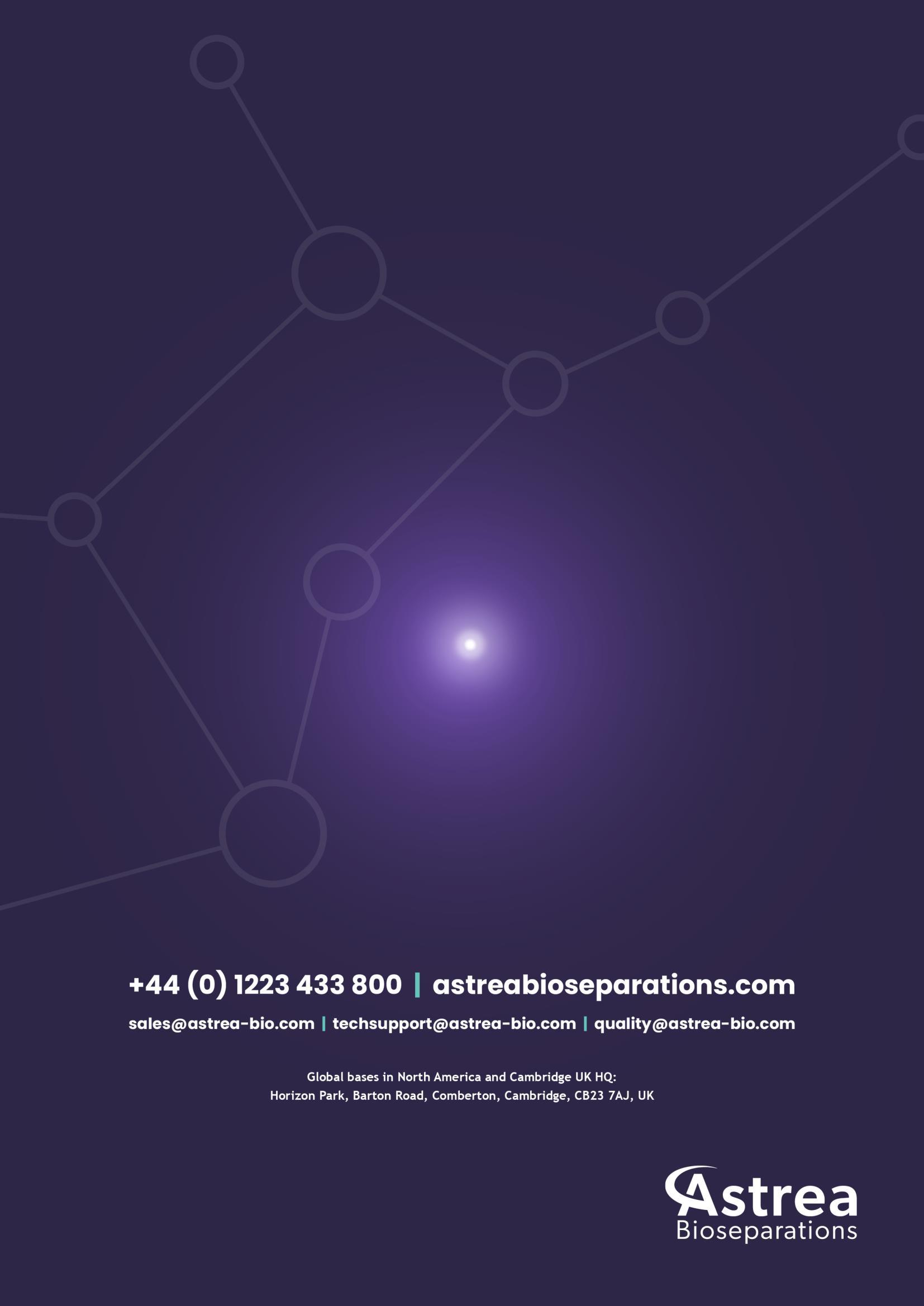

IMPORTANT NOTES
• Read this technical user guide before using the capsule
• The Ampyx LentiHERO® chromatography capsule is provided dry
• This product is intended for single batch use. A clean-in-place method (CIP) is provided. As feedstocks and processes vary, it is recommended that the performance of this product is validated after CIP
• This technical information can change without notice. For the latest information, please refer to the Astrea Bioseparations website for the most current version of this document


INTRODUCTION
Ampyx LentiHERO® is an axial-flow, pre-packed chromatography capsule, designed for manual or LC system use for the downstream processing of viral vectors from cell culture feedstock, which can be used to flow in either direction.
Ampyx LentiHERO® consists of a proprietary high-flow and high-capacity composite nanofiber, AstreAdept®, housed in a protective shell specifically designed to reduce void volume.
The combined characteristic of a large flow path diameter, weak anion-exchange chemistry, and mild elution conditions enables high recovery of purified viral particles.
PRODUCT DESCRIPTION

Luer lock with cap
Capsule prepacked with AstreAdept® chromatography matrix

Luer lock with cap
TECHNICAL DATA
SPECIFICATIONS
LIGAND: Weak anion exchange
TYPICAL DYNAMIC BINDING CAPACITY:
Bovine serum albumin at 1 mg/mL in 10 mM at Tris pH 8 > 60 mg/mL
MAXIMUM PRESSURE AT 20 ºC: 4 Bar | 0.4 MPa | 51 psi
BED VOLUME (BV): 0.1 mL
NOMINAL VOID VOLUME: 0.6 mL
RECOMMENDED OPERATIONAL FLOW RATE: 1.21.2 mL/min
RECOMMENDED PRE-CAPSULE PRESSURE: 3 Bar | 0.3 MPa | 43 psi
CHEMICAL STABILITY:
Compatible with buffers commonly used in bioprocessing, including 20% EtOH, 1 M acetic acid, 1 M NaOH, and solutions containing up to 10 mM EDTA
CONNECTIONS: Luer
VENT VALVE: N/A
REPEATED USE: Single batch use
MATERIALS OF CONSTRUCTION: HOUSING: Polypropylene FUNCTIONAL MEMBRANE: Modified cellulose acetate

Ampyx LentiHERO®
OPERATION
WARNING
Do not use high concentrations of organic solvents, for example, greater than 20% EtOH or 30% isopropyl alcohol.
Wear appropriate personal protective equipment during operation.
Deviation from recommended guidelines could result in personal harm or damage to the product or material.
Lentiviral vector feedstocks vary considerably in production method, lentiviral vector titer, genetic payload, and contamination profile. All these factors can influence the performance of a chromatography step. Optimization for use with any feedstock may be required.
Preparation of lentiviral vector feed
A general process is described below as an example of a purification process for lentiviral vectors
All lentiviral vector feeds should be treated with endonuclease before clarification (e.g., 50 u/mL for 1 hour).
Lentiviral expression system
Adherent/suspension
Clarification
Centrifugation or DEPTH filtration terminating in 1 µM followed by 0.45 µM filtration
Screening of clarification processes can be performed in parallel with Nereus® spin columns (product code: NL100100) or in series using the Ampyx LentiHERO® (product code: LH200400).

Buffers
Processing VSV-G pseudotyped lentiviral vectors with buffers containing arginine has been demonstrated to give significant improvements in recovery (e.g., ~80% recovery from a load of 2.3E+9 TU/mL). Therefore, we recommend the VSV-G Buffers for use with VSV-G pseudotyped lentiviral vectors.
For non-VSV-G pseudotyped lentiviral vectors, we recommend starting with the Universal Buffers, and screening for optimization. VSV-G
A SANITIZATION:
M NaOH
B HIGH CONDUCTIVITY/STRIP: 20 mM Tris, 2 M NaCl, pH 7.2
C EQUILIBRATION: 20 mM Tris, 20 mM MgCl2, 50 mM arginine, pH 7.2
D ELUTION:
LOAD
20 mM Tris, 20 mM MgCl2, 0.8 M arginine, pH 7.2
Add 10% sucrose if the pool is to be frozen and thawed before further processing
Dilute with buffer D, 1 part in 16 parts of the load, to give 50 mM arginine in the load Universal
A SANITIZATION: 0.5 M NaOH
B HIGH CONDUCTIVITY/STRIP: 20 mM Tris, 2 M NaCl, pH 7–8
C EQUILIBRATION: 20 mM Tris, 20 mM MgCl2, pH 7–8
D ELUTION:

20 mM Tris, 20 mM MgCl2, 0.6 M NaCl, pH 7–8. Add 10% sucrose if the pool is to be frozen and thawed before further processing
Buffers
Buffers
Installation
Use
with a liquid chromatography system
1. To minimize the hold up volume in the system, remove the mixer from the flow path if possible. Attach the Ampyx LentiHERO® to the chromatography system with appropriate tubing. For example, green PEEK, 1/16" OD x 0.75 mm" ID, and finger tight connectors with appropriate luer connectors.
2. Attach the column outlet position from the chromatography system to one face of the Ampyx LentiHERO® , and the column inlet to the opposite face
3. If possible, set the system in upflow or invert the unit so that flow is entering on the opposite face to the intended load direction. Run 10 mL of water through the Ampyx LentiHERO® at 1 mL/min to remove air.
4. If required, run 10 mL of sanitization buffer A at 1 mL/min, then hold for 30 minutes.
5. Switch the column to downflow and run 20 mL of high conductivity/strip buffer B through the Ampyx LentiHERO® to charge the unit.
6. Equilibrate with 10 mL of low conductivity equilibration buffer C at 1.2 mL/min, until pH and conductivity are stable.
7. The system is now ready to load clarified feed that has been treated with endonuclease.
Use with a peristaltic pump system
1. Place the peristaltic pump in a clean and stable location.
2. Attach the appropriate tubing into the pump head as per manufacturer’s recommendations. Ensure the tubing fits securely and without kinks.
3. Test the flow rate of the tubing by priming the pump with 20% EtOH or sanitization buffer A. Collect the liquid from the outlet into a clean tared container over 60 seconds and record the volume. Adjust the rpm of the pump and retest until the desired flow rate is achieved (1 mL/min).
4. Attach tubing to the bottom inlet of the Ampyx LentiHERO® , and appropriate tubing to one face of the Ampyx LentiHERO® . Ensure the tubing leaving the Ampyx LentiHERO® can connect with appropriate collection tubes or waste collection vessel.
5. Invert the unit so water is entering the opposite face of the unit to the intended load direction. Collect 5 mL of water through the Ampyx LentiHERO® to remove air
6. If required, collect 5 mL of sanitization buffer A at 1 mL/min, check the pH has attained the correct value, collect more buffer. If not, then check again when the pH has reached the value of the sanitization buffer. Hold for 30 minutes.

7. Run 10 mL of the high conductivity buffer B through the Ampyx LentiHERO® to charge the unit. Check the pH has reached the same value as the buffer B and repeat until that pH value has been attained.
8. Equilibrate with 10 mL of low conductivity equilibration buffer C at 1.2 mL/min, until pH and conductivity are stable.
9. The Ampyx LentiHERO® is now ready to load clarified feed that has been treated with endonuclease.
Manual use with a syringe
1. Attach a 5 mL syringe filled with water to one face of the Ampyx LentiHERO®
2. Invert the unit. Run 5 mL of water through the Ampyx LentiHERO® to remove air. If required, run 5 mL of sanitization buffer A through the Ampyx LentiHERO®, and then hold for 30 minutes.
3. Run 10 mL of high conductivity buffer B through the Ampyx LentiHERO® to charge the unit.
4. Equilibrate with 2 x 5 mL of low conductivity equilibration buffer C, until pH and conductivity are stable.
5. The Ampyx LentiHERO® is now ready to load clarified feed that has been treated with endonuclease.

Chromatography method
1. Install, sanitize, charge, and equilibrate the Ampyx LentiHERO® as described in the above Installation section.
All steps (except where noted) are run at 1.2 mL/min.
2. Load clarified feed to approximately 4E+9 TU of lentiviral vectors/mL of adsorbent.
3. Wash with 15 mL of equilibration buffer.
4. Prime the system with elution buffer D to ensure minimal dilution and elute with 5 mL, collecting the elution peak by UV absorbance. Peak volume will be determined by hold up in the system and tubing.
a. When using VSV-G Buffers, arginine will act as the as the eluting salt. In this case, it is not necessary to dilute the elution pool.
b. When using the Universal Buffers, the elution peak should be diluted immediately 1:1 with the equilibration buffer or an appropriate media to lower overall conductivity to approximately 30 mS/cm. For example, the elution peak can be collected into an equal volume of equilibration buffer, including any appropriate stabilizing additives.
c. Non-VSV-G pseudotyped lentiviral vectors may require optimization of the elution conditions, a 15 mL gradient of 1 M NaCl in 20 mM Tris, pH 7.2, 20 mM MgCl2 is recommended.
5. NOTE: WASH WITH 15 mL OF HIGH CONDUCTIVITY BUFFER B TO REMOVE THE MGCL2 PRIOR TO ANY CIP OR SANITIZATION STEP AFTER USE, IF REUSING.
6. Clean in place with 10 mL of strip buffer.
7. Sanitize with 10 mL of 0.5 M NaOH at 1 mL/min.
The Ampyx LentiHERO® can now be disposed of safely or recharged and re-equilibrated for use with the same target.

STORAGE CONDITIONS
If unused, store the capsule dry at room temperature. If used, clean the device with 0.5 M sodium hydroxide as indicated, re-equilibrate to neutral pH, and fill the capsule with 20% EtOH between 2 ºC (36 ºF) and 8 ºC (46 ºF) away from direct sunlight. Keep caps on the capsule until use. Do not freeze.
It is recommended that Ampyx LentiHERO® performance is validated after storage.

TROUBLESHOOTING
Problem
High back pressure during loading
Lentiviral vectors fail to bind to the Ampyx LentiHERO®
Probable cause
Early breakthrough of lentiviral vectors
Incomplete clarification
Reduced recovery of lentiviral vectors
Conductivity of load too high
1. Higher TU titer than expected
Or
2. Competitive binding with other impurities
Instability of lentiviral vectors
Action
1. Follow recommended procedure for clarification. Use a larger surface area of filter train or DEPTH filters between 1 µM to 0.45 µM
2. Diafilter with 100 kDa molecular weight cut off (MWCO) membrane in equilibration buffer at 100 mM salt
Dilute load with equilibration buffer until conductivity is approximately 15 mS/cm
1. Check TU of load
2. Check dsDNA contamination in feed
Optimize removal of charged contaminants using diafiltration (e.g., buffer exchange with 100 kDa molecular weight membrane in equilibration buffer at 100 mM salt)

Screen additional elution salts, for example NaCl, and additives to stabilize the lentiviral vectors and add these to the elution and the diluent if using NaCl in the elution, for example 10% sucrose, or trehalose. The optimal amounts will be dependent on vector and gene of interest
QUALITY ASSURANCE
The product meets the standards as described below.
COMPLIANCE OF MATERIALS:
DECLARATIONS OF SUITABILITY:
QUALITY:
COMPLIANCE OF PERFORMANCE AND IDENTIFICATION:
All wetted parts have been assessed for low toxicity compliance and biocompatibility against either USP VI <88>, ISO 10993, 21CFR Part 177, or by risk assessment
TSE/BSE free, non-animal derived, nitrosamine free statements available
Manufactured within an ISO 9001:2015 Quality Management System, the product is controlled, traceable, and released through the Quality function. For research use only
Flow test and inspection



